

PAGE 18
 By Jerry Adams
By Jerry Adams
Copyright © 1998
Token descriptions:
FLAME ROOM / HOT WELLS
GOOD FOR / 25 / IN TRADE
Alum-rd-25mm (circa: 1944-77, San Antonio, Texas)
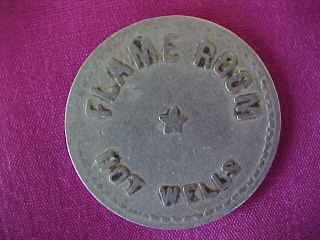
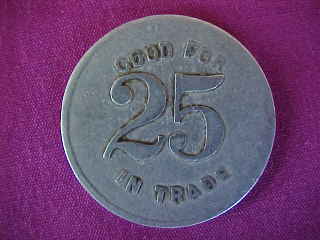
FLAME ROOM / HOT WELLS
GOOD FOR / 5 / IN TRADE
Alum-rd-20mm
FLAME ROOM / HOT WELLS
GOOD FOR / 50 / IN TRADE
Alum-rd-29mm
Sometimes a maverick token, by it’s wording, leads you in several directions. This token had two clues, Flame Room and Hot Wells. The name Hot Wells led me to a postal directory, and the only Hot Wells I could find was in Louisiana. The name Flame Room, sounded like a sauna bath to me, and I suspected the token was from a Turkish bath facility in the town of Hot Wells, Louisiana. I was wrong. A mention of the token in a conversation with John Byars, prompted him to tell me the real source of the token.
What is now known as the San Antonio State Hospital, was in 1892, known as the Southwestern Lunatic Asylum. In that year, the discovery of an artesian well on the grounds of the asylum, changed the name of the area for the next one hundred years to Hot Wells. As soon as the original artesian well was discovered in 1892, the sulfurized water was deemed unfit to drink by the board of directors of the asylum (one of whom, ironically was the man whose name is synonymous with tokens without town and state, Sam Maverick). The directors wisely chose to lease the water rights and use the money for an alternate water source. The first lease holder, was Charles Scheuermeyer, who ran the Southwestern Park and Hot Sulphur Natatorium from 1892 to 1893, near the present site of Hot Wells Hotel.
On May 5, 1893, a Mr. McCellan Shacklett outbid the competition for lease rights to the spring for the next ten years. Under the terms of his lease, he had to build a first class bathhouse and hotel, and pay the huge sum of $500 per year. The city of San Antonio also extended streetcar lines to the area about that time, and the newly built complex was called Natural Hot Springs Wells, or Hot Sulphur Baths.
Such mineral water resorts were common in the 1890’s and early 1900’s across the country, looking at any list of town names will reveal Mineral Wells, Wizard Wells, Hot Springs, and Saratoga Springs to name a few. The hot baths were thought to cure everything from liver ailments to baldness. A secondary function of these resorts was social, and many featured attractions such as formal balls, dinners, dances, plays, musicals and parties. Hot Wells added a small menagerie of animals near the baths, that featured a black bear sent by none other than Judge Roy Bean.
On December 23, 1894, in the early morning hours, fire struck the resort, and Mr. Shacklett himself rescued six patrons personally from guest rooms. The entire structure was totally destroyed however. He lost his lease on the site, when the owners decided the temporary bathhouse he built after the fire, did not live up to the terms of the agreement.
In 1900, a new group of investors opened the Texas Hot Sulphur Water Sanatorium Company, with Otto Koelhler as president. The new company purchased the land, and built a new facility which included three swimming pools, and a three story brick building with eighty guest rooms. All the latest appointments were built into the resort: steam heat, telephones, electric lights, solid porcelain tubs, and steam baths, Turkish, Russian and Roman baths. The swimming pools were lined with white glazed bricks. The Hot Wells resort reached the pinnacle of its popularity between 1900 and 1917. Other attractions adjacent to the resort included an ostrich farm (for the ladies to acquire the ostrich plumes so fashionable then), and a bowling club. By 1906, it was estimated that 2000 guests were turned away due to lack of space. So in 1907, and addition added some 90 rooms as well as extensive landscaping, which included a palm garden.
view of Hot Wells 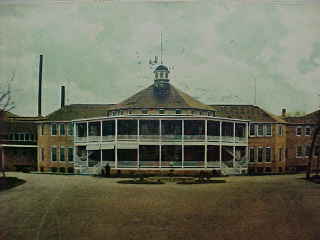 Resort circa 1906
Resort circa 1906
A railroad spur was built to the resort about 1908, and in 1909, Mr. E. H. Harriman, railroad tycoon visited the hotel in his private railcar. If his name rings a bell, his name was mentioned several times in the movie "Butch Cassidy and the Sundance Kid" as the employer of the express car worker, Woodcock. About that time, the Star Film Company established an office in San Antonio, and made films there. Many famous persons of that era visited the Hot Wells resort, including Cecil B. deMille, Rudolph Valentino, Will Rogers, Hoot Gibson, Tom Mix, Teddy Roosevelt, and Douglas Fairbanks. The popularity of the resort continued until World War I. During the war, some officers and families from Brooks Field were housed in the resort. Prohibition had a negative impact also, and by 1923, the resort was sold.
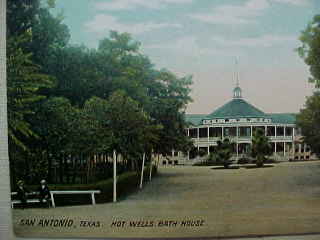
The Christian Scientists bought the hotel in 1923, and converted it into the El Dorado School. The hotel was used as a dormitory, and the bathhouse was converted into classrooms. Then, on January 17, 1925, fire again ravaged the complex, leaving only a shell.
In 1927, the Hot Wells Tourist Court was opened on the site, and ownership change often in the ensuing years. Cabins were built, and the pool and the bathhouse were maintained again. From 1930 to 1933, a sanitarium was also operated on the site.
In 1942, the 21 acre site was sold to Mrs. Cleo S. Jones and her husband Ralph Jones. They opened a trailer park and motel on the site. In 1944, the Joneses converted the bathhouse into the FLAME ROOM, which was a neighborhood bar and grill. The bathhouse still functioned as a swimming pool however, and the Jones allowed swimmers into the bathhouse for one dollar. By the mid-1970’s, most of the cabins were vacant, and business had dwindled.
In 1977, the Joneses finally closed the FLAME ROOM and auctioned off the contents of the hotel, and sold the property to Kathryn Scheer. Ms. Scheer hoped to revitalize the old resort as a holistic health center. For a third time, fire struck the buildings, on June 27, 1988, the bathhouse was struck by lightning, and the building was reduced to the outer brick shell once again. Although the building was on the National Register of Historic Places, it was uninsured.
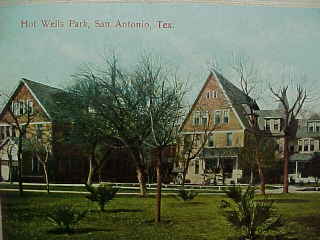
Reference: San Antonio Uncovered
Special thanks to John Byars for providing research and photos.
on to page 19 of our token web pages....
updated 6 feb 2000